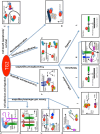Physiological, pathological, and structural implications of non-enzymatic protein-protein interactions of the multifunctional human transglutaminase 2
- PMID: 25943306
- PMCID: PMC11113818
- DOI: 10.1007/s00018-015-1909-z
Physiological, pathological, and structural implications of non-enzymatic protein-protein interactions of the multifunctional human transglutaminase 2
Abstract
Transglutaminase 2 (TG2) is a ubiquitously expressed member of an enzyme family catalyzing Ca(2+)-dependent transamidation of proteins. It is a multifunctional protein having several well-defined enzymatic (GTP binding and hydrolysis, protein disulfide isomerase, and protein kinase activities) and non-enzymatic (multiple interactions in protein scaffolds) functions. Unlike its enzymatic interactions, the significance of TG2's non-enzymatic regulation of its activities has recently gained importance. In this review, we summarize all the partners that directly interact with TG2 in a non-enzymatic manner and analyze how these interactions could modulate the crosslinking activity and cellular functions of TG2 in different cell compartments. We have found that TG2 mostly acts as a scaffold to bridge various proteins, leading to different functional outcomes. We have also studied how specific structural features, such as intrinsically disordered regions and embedded short linear motifs contribute to multifunctionality of TG2. Conformational diversity of intrinsically disordered regions enables them to interact with multiple partners, which can result in different biological outcomes. Indeed, ID regions in TG2 were identified in functionally relevant locations, indicating that they could facilitate conformational transitions towards the catalytically competent form. We reason that these structural features contribute to modulating the physiological and pathological functions of TG2 and could provide a new direction for detecting unique regulatory partners. Additionally, we have assembled all known anti-TG2 antibodies and have discussed their significance as a toolbox for identifying and confirming novel TG2 regulatory functions.
Conflict of interest statement
The authors declare that they have no conflict of interest.
Figures



Similar articles
-
Extracellular TG2: emerging functions and regulation.FEBS J. 2011 Dec;278(24):4704-16. doi: 10.1111/j.1742-4658.2011.08346.x. Epub 2011 Nov 21. FEBS J. 2011. PMID: 21902810 Free PMC article. Review.
-
Discovery and Characterization of PROTACs Targeting Tissue Transglutaminase (TG2).J Med Chem. 2023 Jul 27;66(14):9445-9465. doi: 10.1021/acs.jmedchem.2c01859. Epub 2023 Jul 14. J Med Chem. 2023. PMID: 37449845 Free PMC article.
-
Biological Implications and Functional Significance of Transglutaminase Type 2 in Nervous System Tumors.Cells. 2024 Apr 11;13(8):667. doi: 10.3390/cells13080667. Cells. 2024. PMID: 38667282 Free PMC article. Review.
-
Cellular functions of tissue transglutaminase.Int Rev Cell Mol Biol. 2012;294:1-97. doi: 10.1016/B978-0-12-394305-7.00001-X. Int Rev Cell Mol Biol. 2012. PMID: 22364871 Free PMC article. Review.
-
Transglutaminase 2 has opposing roles in the regulation of cellular functions as well as cell growth and death.Cell Death Dis. 2016 Jun 2;7(6):e2244. doi: 10.1038/cddis.2016.150. Cell Death Dis. 2016. PMID: 27253408 Free PMC article. Review.
Cited by
-
Transglutaminase 2 Up-Regulation Is Associated with Inflammatory Response in PBMC from Healthy Subjects with Hypovitaminosis D.Med Sci (Basel). 2018 Nov 16;6(4):103. doi: 10.3390/medsci6040103. Med Sci (Basel). 2018. PMID: 30453584 Free PMC article.
-
Spotlight on the Transglutaminase 2-Heparan Sulfate Interaction.Med Sci (Basel). 2019 Jan 4;7(1):5. doi: 10.3390/medsci7010005. Med Sci (Basel). 2019. PMID: 30621228 Free PMC article. Review.
-
Pharmacologic inhibition of the enzymatic effects of tissue transglutaminase reduces cardiac fibrosis and attenuates cardiomyocyte hypertrophy following pressure overload.J Mol Cell Cardiol. 2018 Apr;117:36-48. doi: 10.1016/j.yjmcc.2018.02.016. Epub 2018 Mar 2. J Mol Cell Cardiol. 2018. PMID: 29481819 Free PMC article.
-
Transglutaminases and Obesity in Humans: Association of F13A1 to Adipocyte Hypertrophy and Adipose Tissue Immune Response.Int J Mol Sci. 2020 Nov 5;21(21):8289. doi: 10.3390/ijms21218289. Int J Mol Sci. 2020. PMID: 33167412 Free PMC article.
-
Overexpression of TG2 enhances the differentiation of ectomesenchymal stem cells into neuron‑like cells and promotes functional recovery in adult rats following spinal cord injury.Mol Med Rep. 2019 Sep;20(3):2763-2773. doi: 10.3892/mmr.2019.10502. Epub 2019 Jul 15. Mol Med Rep. 2019. PMID: 31322240 Free PMC article.
References
-
- Lorand L, Graham RM. Transglutaminases: crosslinking enzymes with pleiotropic functions. Nat Rev Mol Cell Biol. 2003;4(2):140–156. - PubMed
-
- Kiraly R, Demeny M, Fesus L. Protein transamidation by transglutaminase 2 in cells: a disputed Ca2+-dependent action of a multifunctional protein. FEBS J. 2011;278(24):4717–4739. - PubMed
-
- Nakaoka H, Perez DM, Baek KJ, Das T, Husain A, Misono K, Im MJ, Graham RM. Gh: a GTP-binding protein with transglutaminase activity and receptor signaling function. Science. 1994;264(5165):1593–1596. - PubMed
Publication types
MeSH terms
Substances
LinkOut - more resources
Full Text Sources
Miscellaneous

